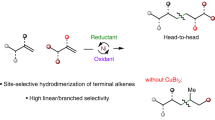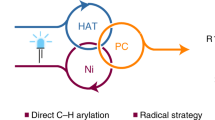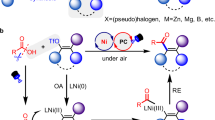Abstract
Transition-metal-catalysed, redox-neutral dehydrosilylation of alkenes is a long-standing challenge in organic synthesis, with current methods suffering from low selectivity and narrow scope. In this study, we report a general and simple method for the manganese-catalysed dehydrosilylation and hydrosilylation of alkenes, with Mn2(CO)10 as a catalyst precursor, by using a ligand-tuned metalloradical reactivity strategy. This enables versatility and controllable selectivity with a 1:1 ratio of alkenes and silanes, and the synthetic robustness and practicality of this method are demonstrated using complex alkenes and light olefins. The selectivity of the reaction has been studied using density functional theory calculations, showing the use of an iPrPNP ligand to favour dehydrosilylation, while a JackiePhos ligand favours hydrosilylation. The reaction is redox-neutral and atom-economical, exhibits a broad substrate scope and excellent functional group tolerance, and is suitable for various synthetic applications on a gram scale.

This is a preview of subscription content, access via your institution
Access options
Access Nature and 54 other Nature Portfolio journals
Get Nature+, our best-value online-access subscription
$29.99 / 30 days
cancel any time
Subscribe to this journal
Receive 12 print issues and online access
$259.00 per year
only $21.58 per issue
Buy this article
- Purchase on Springer Link
- Instant access to full article PDF
Prices may be subject to local taxes which are calculated during checkout




Similar content being viewed by others
Data availability
All data generated or analysed during this study are included in this Article and its Supplementary Information. Crystallographic data have been deposited at the Cambridge Crystallographic Data Centre (CCDC) as CCDC 1937151 (5), 1937156 (6) and 1937154 (19) and can be obtained free of charge from the CCDC via www.ccdc.cam.ac.uk/getstructures.
References
Troegel, D. & Stohrer, J. Recent advances and actual challenges in late transition metal catalyzed hydrosilylation of olefins from an industrial point of view. Coord. Chem. Rev. 255, 1440–1459 (2011).
Hill, R. M. (ed.) in Silicone Surfactants, Surfactants Science Series Vol. 86 (Marcel Dekker, 1999).
Franz, A. K. & Wilson, S. O. Organosilicon molecules with medicinal applications. J. Med. Chem. 56, 388–405 (2013).
Sore, H. F., Gallowaya, W. & Spring, D. R. Palladium-catalysed cross-coupling of organosilicon reagents. Chem. Soc. Rev. 41, 1845–1866 (2012).
Sanchez, C., Belleville, P., Popall, M. & Nicole, L. Applications of advanced hybrid organic–inorganic nanomaterials: from laboratory to market. Chem. Soc. Rev. 40, 696–753 (2011).
Min, G. K., Hernandez, D. & Skrydstrup, T. Efficient routes to carbon–silicon bond formation for the synthesis of silicon-containing peptides and azasilaheterocycles. Acc. Chem. Res. 46, 457–470 (2013).
Cheng, C. & Hartwig, J. F. Catalytic silylation of unactivated C–H bonds. Chem. Rev. 115, 8946–8975 (2015).
Bähr, S. & Oestreich, M. Electrophilic aromatic substitution with silicon electrophiles: catalytic Friedel–Crafts C−H silylation. Angew. Chem. Int. Ed. 56, 52–59 (2017).
Corey, J. Y. Reactions of hydrosilanes with transition metal complexes and characterization of the products. Chem. Rev. 111, 863–1071 (2011).
Marciniec, B., Maciejewski, H., Pietraszuk, C. & Pawluć, P. in Hydrosilyaltion: A Comprehensive Review on Recent Advances (ed. Marciniec, B.) (Springer, 2009).
Speier, J. L., Webster, J. A. & Barnes, G. H. The addition of silicon hydrides to olefinic double bonds. Part II. The use of group VIII metal catalysts. J. Am. Chem. Soc. 79, 974–979 (1957).
Markó, I. E. et al. Selective and efficient platinum(0)-carbene complexes as hydrosilylation catalysts. Science 298, 204–206 (2002).
Du, X. & Huang, Z. Advances in base-metal-catalyzed alkene hydrosilylation. ACS Catal. 7, 1227–1243 (2017).
Sun, J. & Deng, L. Cobalt complex-catalyzed hydrosilylation of alkenes and alkynes. ACS Catal. 6, 290–300 (2016).
Nakajima, Y. & Shimada, S. Hydrosilylation reaction of olefins: recent advances and perspectives. RSC Adv. 5, 20603–20616 (2015).
Millan, A., Towns, E. & Maitlis, P. M. The direct conversion of α-olefins into vinyl- and allyl-silances catalysed by rhodium complexes. J. Chem. Soc. Chem. Commun. 673–674 (1981).
Cheng, C., Simmons, E. M. & Hartwig, J. F. Iridium-catalyzed, diastereoselective dehydrogenative silylation of terminal alkenes with (TMSO)2MeSiH. Angew. Chem. Int. Ed. 52, 8984–8989 (2013).
LaPointe, A. M., Rix, F. C. & Brookhart, M. Mechanistic studies of palladium(ii)-catalyzed hydrosilation and dehydrogenative silation reactions. J. Am. Chem. Soc. 119, 906–917 (1997).
Bokka, A. & Jeon, J. Regio- and stereoselective dehydrogenative silylation and hydrosilylation of vinylarenes catalyzed by ruthenium alkylidenes. Org. Lett. 18, 5324–5327 (2016).
Takeuchi, R. & Yasue, H. Cationic rhodium complex-catalyzed highly selective dehydrogenative silylation of styrene. Organometallics 15, 2098–2102 (1996).
Naumov, R. N., Itazaki, M., Kamitani, M. & Nakazawa, H. Selective dehydrogenative silylation-hydrogenation reaction of divinyldisiloxane with hydrosilane catalyzed by an iron complex. J. Am. Chem. Soc. 134, 804–807 (2012).
Atienza, C. et al. Bis(imino)pyridine cobalt-catalyzed dehydrogenative silylation of alkenes: scope, mechanism and origins of selective allylsilane formation. J. Am. Chem. Soc. 136, 12108–12118 (2014).
Jiang, Y., Blacque, O., Fox, T., Frech, C. M. & Berke, H. Highly selective dehydrogenative silylation of alkenes catalyzed by rhenium complexes. Chem. Eur. J. 15, 2121–2128 (2009).
Toutov, A. A. et al. Silylation of C–H bonds in aromatic heterocycles by an earth-abundant metal catalyst. Nature 518, 80–84 (2015).
Cheng, C. & Hartwig, J. F. Rhodium-catalyzed intermolecular C–H silylation of arenes with high steric regiocontrol. Science 343, 853–857 (2014).
Carney, J. R., Dillon, B. R. & Thomas, S. P. Recent advances of manganese catalysis for organic synthesis. Eur. J. Org. Chem. 3912–3929 (2016).
Liu, W. & Ackermann, L. Manganese-catalyzed C–H activation. ACS Catal. 6, 3743–3752 (2016).
Yang, X. & Wang, C. Manganese-catalyzed hydrosilylation reactions. Chem. Asian J. 13, 2307–2315 (2018).
Pratt, S. L. & Faltynek, R. A. Hydrosilation catalysis via silylmanganese carbonyl complexes: thermal vs. photochemical activation. J. Organomet. Chem. 258, C5–C8 (1983).
Hilal, H. S., Abu-Eid, M., Al-Subu, M. & Khalaf, S. Hydrosilylation reactions catalysed by decacarbonyldimanganese(0). J. Mol. Catal. 39, 1–11 (1987).
Hilal, H. S., Suleiman, M. A., Jondi, W. J., Khalaf, S. & Masoud, M. M. Poly(siloxane)-supported decacarbonyldimanganese(0) catalyst for terminal olefin hydrosilylation reactions: the effect of the support on the catalyst selectivity, activity and stability. J. Mol. Catal. 144, 47–59 (1999).
Price, J. S., Emslie, D. J. H. & Britten, J. F. Manganese silylene hydride complexes: synthesis and reactivity with ethylene to afford silene hydride complexes. Angew. Chem. Int. Ed. 56, 6223–6227 (2017).
Carney, J. R., Dillon, B. R., Campbell, L. & Thomas, S. P. Manganese-catalyzed hydrofunctionalization of alkenes. Angew. Chem. Int. Ed. 57, 10620–10624 (2018).
Yang, X. & Wang, C. Diverse fates of β-silyl radical under manganese catalysis: hydrosilylation and dehydrogenative silylation of alkenes. Chin. J. Chem. 36, 1047–1051 (2018).
Mukhopadhyay, T. K., Flores, M., Groya, T. L. & Trovitch, R. J. A β-diketiminate manganese catalyst for alkene hydrosilylation: substrate scope, silicone preparation and mechanistic insight. Chem. Sci. 9, 7673–7680 (2018).
Luo, Y. R. Comprehensive Handbook of Chemical Bond Energies (CRC Press, 2007).
Friestad, G. K. & Qin, J. Intermolecular alkyl radical addition to chiral N-acylhydrazones mediated by manganese carbonyl. J. Am. Chem. Soc. 123, 9922–9923 (2001).
McMahon, C. M., Renn, M. S. & Alexanian, E. J. Manganese-catalyzed carboacylations of alkenes with alkyl iodides. Org. Lett. 18, 4148–4150 (2016).
Nuhant, P. et al. Visible‐light‐initiated manganese catalysis for C–H alkylation of heteroarenes: applications and mechanistic studies. Angew. Chem. Int. Ed. 56, 15309–15313 (2017).
Wang, L., Lear, J. M., Rafferty, S. M., Fosu, S. C. & Nagib, D. A. Ketyl radical reactivity via atom transfer catalysis. Science 362, 225–229 (2018).
Yang, X. & Wang, C. Dichotomy of manganese catalysis via organometallic or radical mechanism: stereodivergent hydrosilylation of alkynes. Angew. Chem. Int. Ed. 57, 923–928 (2018).
Herrick, R. S., Herrinton, T. R., Walker, H. W. & Brown, T. L. Rates of halogen atom transfer to manganese carbonyl radicals. Organometallics 4, 42–45 (1985).
Docherty, J. H., Peng, J., Dominey, A. P. & Thomas, S. P. Activation and discovery of earth-abundant metal catalysts using sodium tert-butoxide. Nat. Chem. 9, 595–600 (2017).
Hicks, J. D., Hyde, A. M., Cuezva, A. M. & Buchwald, S. L. Pd-catalyzed N-arylation of secondary acyclic amides: catalyst development, scope and computational study. J. Am. Chem. Soc. 131, 16720–16734 (2009).
Fischer, H. The persistent radical effect: a principle for selective radical reactions and living radical polymerizations. Chem. Rev. 101, 3581–3610 (2000).
Leifert, D. & Studer, A. The persistent radical effect in organic synthesis. Angew. Chem. Int. Ed. 59, 74–108 (2020).
Martin, S. & Watson, D. A. Preparation of vinyl silyl ethers and disiloxanes via the silyl-Heck reaction of silyl ditriflates. J. Am. Chem. Soc. 135, 13330–13333 (2013).
Denmark, S. E. & Wang, Z. Highly stereoselective hydrocarbation of terminal alkynes via Pt-catalyzed hydrosilylation/Pd-catalyzed cross-coupling reactions. Org. Lett. 3, 1073–1076 (2001).
Oshima, K. in Science of Synthesis (ed. Fleming, I.) 713–754 (Thieme, 2001).
Whitmore, F. C. & Sommer, L. H. Organo-silicon compounds. II. Silicon analogs of neopentyl chloride and neopentyl iodide: the alpha silicon effect. J. Am. Chem. Soc. 68, 481–484 (1946).
Obradors, C., Martinez, R. M. & Shenvi, R. A. Ph(iPrO)SiH2: an exceptional reductant for metal-catalyzed hydrogen atom transfers. J. Am. Chem. Soc. 138, 4962–4971 (2016).
Tondreau, A. M. et al. Iron catalysts for selective anti-Markovnikov alkene hydrosilylation using tertiary silanes. Science 335, 567–570 (2012).
Jia, X. & Huang, Z. Conversion of alkanes to linear alkylsilanes using an iridium–iron-catalysed tandem dehydrogenation-isomerization-hydrosilylation. Nat. Chem. 8, 157–161 (2016).
Jondi, W., Zyoud, A., Mansour, W., Hussein, A. Q. & Hilal, H. S. Highly active and selective catalysts for olefin hydrosilylation reactions using metalloporphyrins intercalated in natural clays. React. Chem. Eng. 1, 194–203 (2016).
Hu, M.-Y. et al. Ligands with 1,10-phenanthroline scaffold for highly regioselective iron-catalysed alkene hydrosilylation. Nat. Commun. 9, 221 (2018).
Acknowledgements
We thank the National Natural Science Foundation of China (grants 21971108, 21971111, 21702098, 21703118, 21732003 and 21672099), the Fundamental Research Funds for the Central Universities (020514380214), the Natural Science Foundation of Jiangsu Province (grant no. BK20190006), the ‘Innovation & Entrepreneurship Talents Plan’ of Jiangsu Province, the ‘Jiangsu Six Peak Talent Project’, Shandong Provincial Natural Science Foundation (grant no. ZR2017MB038) and start-up funds from Nanjing University for financial support. Y. Liang, G. Wang and J. Han are acknowledged for their helpful suggestions and discussions. X. Wu and Y. Zhao are acknowledged for their help with H2 liberation reactions and X-ray single-crystal structure determination. We also thank K. Liu, Z. Yan, Y. Ning and W. Li for reproducing products 3a, 3v, 4a and 4m and C. Zhu, J. Han, Y. Pang, S. Fang and W. Li for their help with the preparation of this manuscript. The DFT calculations were supported by the High Performance Computing Center of Qufu Normal University.
Author information
Authors and Affiliations
Contributions
J.D., Z.Y. and J.X. conceived and designed the experiments. J.D., Z.Y. and J.M. performed the experiments. J.D. and Z.Y. analysed and discussed the experimental data. X.-A.Y. and L.M. performed DFT calculations and discussed the manuscript. J.X. wrote the manuscript with input from all authors and discussed with C.Z. All the authors have approved the final version of the manuscript.
Corresponding author
Ethics declarations
Competing interests
The authors declare no competing interests.
Additional information
Publisher’s note Springer Nature remains neutral with regard to jurisdictional claims in published maps and institutional affiliations.
Supplementary information
Supplementary Information
Supplementary Tables 1–8, Figs. 1–30, Methods, text, experimental information, NMR, IR, GC-MS, HPLC spectra and references.
Supplementary Data 1
Crystallographic data for compound 5. CCDC reference 1937151.
Supplementary Data 2
Crystallographic data for compound 6. CCDC reference 1937156.
Supplementary Data 3
Crystallographic data for compound 19. CCDC reference 1937154.
Rights and permissions
About this article
Cite this article
Dong, J., Yuan, XA., Yan, Z. et al. Manganese-catalysed divergent silylation of alkenes. Nat. Chem. 13, 182–190 (2021). https://doi.org/10.1038/s41557-020-00589-8
Received:
Accepted:
Published:
Issue Date:
DOI: https://doi.org/10.1038/s41557-020-00589-8



